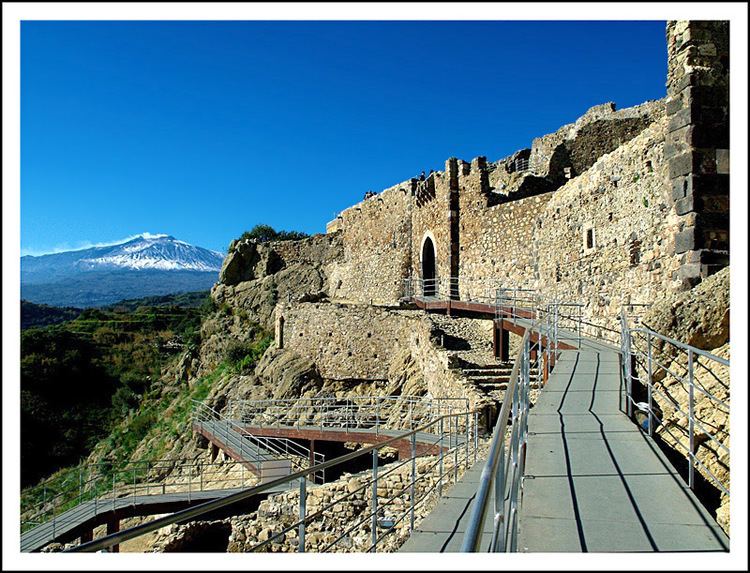Elevation 60 m (200 ft) Time zone CET (UTC+1) | Demonym(s) Calatabianesi Local time Monday 10:43 AM Postal code 95011 | |
 | ||
Frazioni Lapide Pasteria, Ponte Borea, Ciotto, San Marco Weather 16°C, Wind SW at 2 km/h, 56% Humidity | ||
Calatabiano (Sicilian: Cattabbianu) is a comune (municipality) in the province of Catania in Sicily, southern Italy.
Contents
- Map of Calatabiano Province of Catania Italy
- Geography
- History
- Castle
- Chiesa del Santissimo Crocifisso
- Chiesa di Madre di Maria Santissima Annunziata
- Chiesa di Ges e Maria
- Castello di San Marco
- La calata di San Filippo
- Other events
- References
Map of Calatabiano, Province of Catania, Italy
Geography
Calatabiano is located about 60 metres above the sea level. It is located about 42 kilometres northeast of Catania. about 58 kilometres southwest of Messina and about 175 kilometres east of Palermo. The population is about 75% in the center of the town, and about 25% is located in Pasteria Lapide. Calatabiano borders the following municipalities: Castiglione di Sicilia, Fiumefreddo di Sicilia, Giardini-Naxos, Linguaglossa, Piedimonte Etneo, Taormina. The municipality of Calatabiano is a part of Parco fluviale dell'Alcantara (Alcantara River Park).
History
The history of Calatabiano is closely linked to its castle, located 160 meters above the sea level. Calatabiano Castle was founded by the Arabs, who moved from Calatabiano to conquer Taormina in 902. The Arab presence in Calatabiano is clearly visible from the name of the town, which is divided in قلعة ("Kalaat", meaning "castle") and 'to Bian, likely name of the local lord.
After the death of Frederick II, the castle was given to Giovanni Moro by Conrad IV. In 1254, the Pope gave to Giovanni Moro some possessions, including Calatabiano Castle, in exchange for guarantee military aid in the defense of the Kingdom of Sicily.
The Cruyllas enlarged the castle and built the church of Santissimo Crocifisso (the Holy Cross).
In 1544 the pirate Dragut landed on the shore of San Marco beach, stormed and ransacked the village. In 1693 due to the earthquake felt in Sicily and Malta accompanied by the eruption of Mount Etna, the village and castle were abandoned. In 1813 the Sicilian parliament marked the end of feudalism in the island. In the same year Calatabiano was declared an autonomous municipality, the boundaries has been maintained until this day.
Castle
Thanks to the excavations done between the end of the twentieth century and the beginning of the next century, there has been found traces of a castle in the Byzantine era. Because of its great military importance, Swabians and Aragonese improved the Castle’s defence. The Cruyllas enlarged the fortress up to its current size.
“Salone dei Cruyllas”(“Hall of Cruyllas”) and the entry portal are the most interesting places inside the Castle. In the last few decades the castle has been renovated and became a tourist attraction. Bars, pizzerias and conference rooms has been built inside the castle in a modern style. The castle could be reached by a winding road or by a cable car that was built during the restoration of the castle in 2011.
Chiesa del Santissimo Crocifisso
The church of Santissimo Crocifisso (the Holy Cross) is the first church of Calatabiano and it was inaugurated on 4 March 1484. Its Gothic style has a massive crenellated bell tower and two ogival entrances, west and south. Inside the church there is a statue of St. Philip Syriac (protector of Calatabiano). In the bell tower, on the west wall, there is a fresco of the Madonna and Child. The fresco from the early 500 is likely to get a permanent damage because of the humidity.
Chiesa di Madre di Maria Santissima Annunziata
The church of Madre di Maria Santissima Annunziata was built in 1740 with a single nave. It is located in the central of Vittorio Emanuele III square. Inside there is a precious wooden crucifix from 1502 of Giovanni Salvo D'Antonio.
Chiesa di Gesù e Maria
Another ancient place of worship is the Church of Gesù e Maria (Jesus and Mary) from 1697, with masonry facade and white stone.
Castello di San Marco
Known as Castle, San Marco’s Castle is actually a noble residence on the San Marco’s shore. The construction was being built in 1689 by the lord of the time, Ignazio Sebastiano Gravina Prince of Palagonia, and completed in two years. The actual castle looks different from the original building, this is due to the numerous changes made over the decades. In 1856 it was leased to Baron Pasquale Pennisi of Floristella. The Baron changed the Castle with the construction of a winery and some houses for farmers.
La calata di San Filippo
The traditional descent of St. Philip takes place during the feast of St. Philip Syriac, protector of the town, on the Saturday before the third Sunday of May. The tradition started back in 1766. During the descent, the statue of the saint has to be carried by the devotees from the Church of the Holy Cross to the center of the town. The procession begins at 06:30 pm, the devotees run through the bumpy roads of Calatabiano. The feast ends on the fourth Sunday of May.
